How to plant radishes correctly: instructions for beginner gardeners
There are several ways to plant radishes. You can eat it all year round, growing it at home or in a heated greenhouse; the harvest is harvested immediately after the snow melts from winter crops. The most traditional option is to sow radishes in the ground. It does not require special financial or labor resources.
In this article we will tell you in detail how to plant radishes in open ground with seeds, when to sow, what to protect from, what agricultural techniques exist for this.
When to plant radishes in open ground with seeds
Radish seeds are planted in open ground as soon as the snow melts and the soil warms up. Radishes are grown only at temperatures above +2°C. The optimal time for planting is spring or summer, depending on climatic conditions.
Planting in spring
The early radish crop is harvested mainly in the spring months. In regions with a warm climate, its seeds are planted in the ground at the end of March, in regions with a cold climate, for example, in the Urals - in mid-April. In the northern regions and Siberia, radishes begin to be grown from the beginning of May.
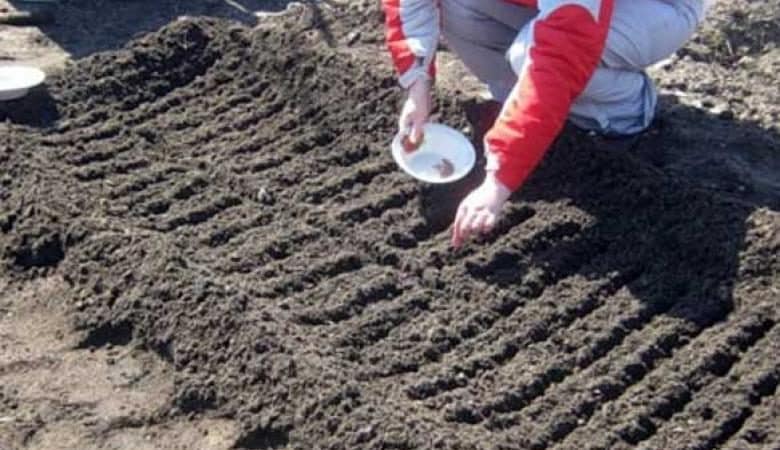
In spring, early-ripening and early-ripening varieties are planted. The average air temperature during planting should be +15-16°C. In 2.5-3 weeks the first harvest will appear. These varieties include Zhara, Carmen, Presto.
Growing in summer
In June, mid-season varieties are grown in the plots; they can be planted three times per season. On average, they ripen in 30-35 days. These varieties include Rubin, Cardinal and Ilka.
Late-ripening varieties are planted in the ground at the end of May or June, depending on the climate. They ripen in 35-50 days and produce a bountiful harvest. Late-ripening varieties are Ice Icicle, Red Giant and Rampouche.
Planting according to the lunar calendar

Rarely a summer resident does not take into account the lunar calendar. The moon affects plant growth, and radishes are no exception. On favorable days it grows faster, on unfavorable days it grows slower.
Lunar calendar 2020 (favorable days):
- February: 12, 13, 14, 15, 19, 20;
- March: 11, 12, 13, 15, 17, 18, 22;
- April: 10, 13, 14, 18, 19;
- May: 11, 12, 15, 16, 17, 20;
- June: 7, 8, 12, 13, 17, 18;
- July: 9, 10, 14, 15;
- September: 6, 7, 8, 11, 12, 13.
Lunar calendar 2020 (unfavorable days):
- February: 9, 10, 11, 21, 22, 23;
- March: 8, 9, 10, 15, 16, 19, 24;
- April: 8, 15, 16, 17, 20, 21, 22, 23;
- May: 7, 13, 14, 18, 19, 22;
- June: 5, 9, 10, 11, 14, 15, 16, 19, 20, 21;
- July: 5, 7, 8, 11, 12, 13, 16, 17, 18, 20;
- September: 2, 4, 5, 9, 10, 14, 15, 16, 17.
The best neighborhood and favorable precursor plants for radish
It is recommended to plant radishes in beds where potatoes, cucumbers, and tomatoes used to grow. Do not plant it after fellow cruciferous vegetables: cabbage, turnips, mustard, horseradish or radish. They have common pests. Planting in the wrong place leads to loss of part of the harvest.
In turn, radishes will be a good predecessor for tomatoes.
Reference. What is the best place to grow radishes in the neighborhood? With onions and garlic. Their smell repels the main pest - the cruciferous flea beetle.
Planting radishes in open ground
Radish is an early ripening and cold-resistant root crop. It is sown from early spring to late autumn in order to obtain a constant harvest throughout the season.
Radish seeds germinate at a temperature of +2-3°C. The plant develops at a temperature of +16-18°C.For it, choose a place sheltered from the wind, which is illuminated by the sun on average 11 hours a day.
Seed preparation and processing
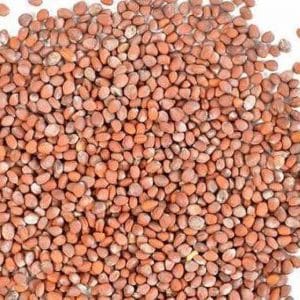 Before sowing, the seeds are prepared and processed so that in the future they grow faster and suffer less pain. Only seeds from last year's harvest are used.
Before sowing, the seeds are prepared and processed so that in the future they grow faster and suffer less pain. Only seeds from last year's harvest are used.
First, the seed material is sorted out, manually or through a sieve with mesh size of about 2 mm, and large, healthy specimens are left. Weak and old seeds will not grow into large fruits. Selected seeds are soaked in plain water.
Reference. When soaking, biostimulants are used if desired. They enrich the seeds with nutrients and increase resistance to disease. Such preparations as Zircon and Ecogel are suitable.
When soaking, the seeds are placed in a damp cloth and left for 12 hours. Then they are immersed in hot water for 20 minutes. This allows you to increase resistance to external factors. Afterwards they are laid out on a cloth and dried. After soaking and heating, the seeds are not stored; they are planted immediately.
Soil preparation
The soil for the plant is loose and neutral. Peat or sand is added to heavy and clayey soils. If the soil is acidic, liming is carried out.
High-quality soil preparation affects the further development of the crop. Therefore, experienced agronomists recommend fertilizing the soil in the fall. Thanks to this method, during the winter nutrients will saturate the soil.
The first thing after harvesting is to remove the weeds from the garden bed where the radishes will be planted and dig up the area. Add peat or humus (0.5 buckets per square meter). The second one is rich in nitrogen - the main thing is to follow the dosage. An excess of the element stimulates the growth of greenery and inhibits the growth of fruits.
Superphosphate is added if desired. Per sq. m. use 1 tbsp. l. substances.The area is dug up again and left until spring. In the spring, 2-4 weeks before planting, the soil is dug up and weeds are removed. The soil is fertilized with compost and wood ash. Per sq. m. add one bucket of compost and 300 g of ash.
Cover the area with black polyethylene and leave until sowing. This method helps the earth warm up faster.
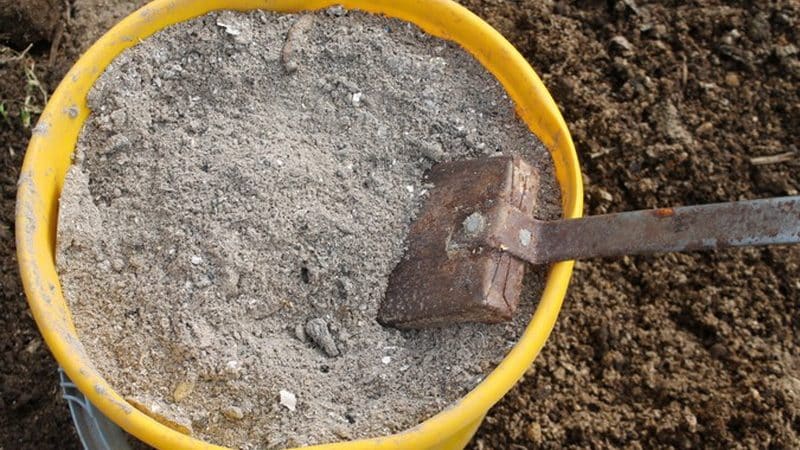
Landing instructions
The root crop is planted with seeds in the soil or grown through seedlings. The seedling method helps to get the harvest a week earlier.
Radishes are grown for seedlings in small containers. Furrows are made in the soil, watered with warm water and seeds are sown. If the container is large, then they are placed at a distance of 30 mm from each other. Sprinkle with earth, cover with film and place on the windowsill. The room temperature must be at least +20°C.
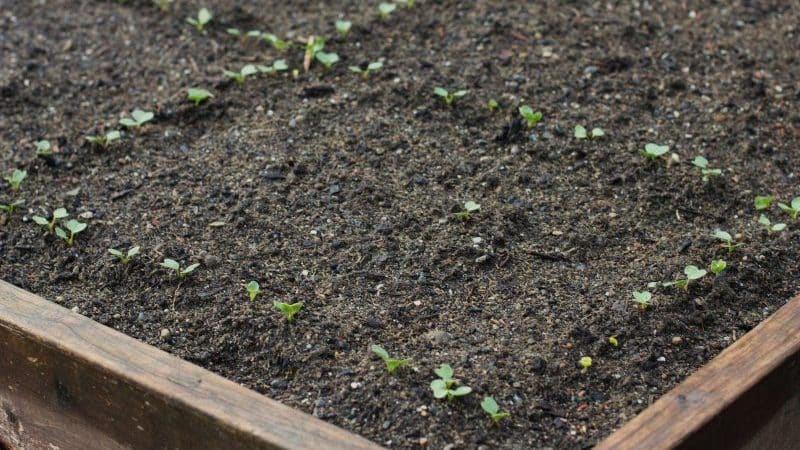
The seedlings are transplanted into open ground after a week. after sowing in grooves, at a distance of 30-50 mm from each other. Sprinkle with earth, water and cover with film for two days. If the soil is fertile, then in the holes before sowing fertilizers They don’t contribute.
When planting seeds in open ground, furrows are made on the soil for sowing at a distance of an average of 20 cm, and watered with water. Ash is used for additional feeding. Then the seeds are laid out individually to a depth of 20 mm. A distance of 60 mm is left between them. The seeds are sprinkled with dry soil, the soil is mulched with sawdust and covered with film.
Further care
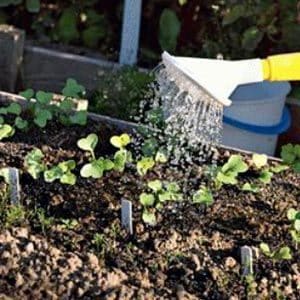
Further care of the root crop involves watering, loosening, weeding the soil and timely fertilizing.
Watering
Radish is a moisture-loving plant. Watering is needed frequently and plentifully. If you do not comply with the crop irrigation requirements at first, the root crops will be bitter and not juicy.
Moisten the soil with water at room temperature (+20-25°C).Watering the seeds with cold water will prevent them from sprouting.
Reference. Insufficient moisture leads to the fact that the plant begins to bolt. The roots do not grow or develop. Excessive watering leads to cracking of the fruits.
Irrigation is carried out in the morning or after six o'clock in the evening. If the weather is hot, then water the radishes twice a day. In other cases, if there is no heavy rain, once a day.
Radishes are not watered with a directed stream at the root - this washes away the soil. For irrigation, use a watering can or hose with spray nozzles.
Top dressing

Radishes are fed twice a season; additional feedings are used if the plant lacks nutrients. Use mineral and organic fertilizers. During growth, it is recommended to use mineral complexes.
The first fertilizing (nitrogen) is carried out 7 days after the first two true leaves appear. The best remedies are urea or saltpeter. For 10 liters of water add 1 tbsp. l. liquid substance. The solution is enough for 1 sq. m.
The second feeding is applied another week later. At this time, the root crop is rounded. At this stage, radishes are fertilized with phosphorus and potassium. For 1 sq. m use the following solution: dilute 1 tbsp in 10 liters of water. l. substances.
Nettle infusion is also a good fertilizer for the crop. The nutrients contained in it help the root crop grow faster.
A tin barrel is filled two-thirds with nettles. Pour warm water to the brim, cover with a lid and leave in the sun. The solution is infused for a week. It is stirred every day. After this, 1 liter of solution is diluted in a bucket of water. Water the infusion between the rows once every two weeks.
Chicken manure contains nitrogen, phosphorus, potassium and magnesium.It is used only in the form of a solution. 1 liter of substance is diluted in 3 liters of water. Stir and add another 10 liters of water, after which the plants are watered.
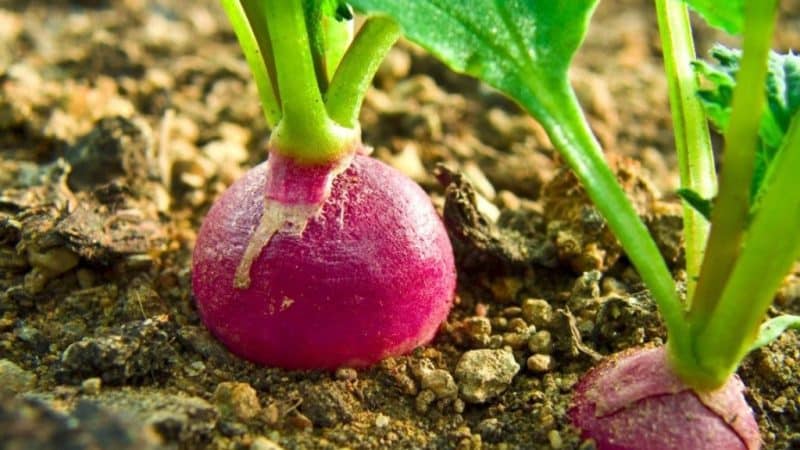
Advice from experienced summer residents
To increase the yield and store it for a long time, experienced summer residents advise trying the following techniques:
- Radish gets along with different crops. It is usually sown with carrots and onions.
- On fertile soils, the root crop is fertilized once per season.
- The radishes are harvested in the morning, and before that evening the beds are watered abundantly. Thanks to this, the root crops are stretched.
- To keep radishes longer, they are pulled out of the soil, the soil is removed and the greens are cut off at a distance of 30 mm from the fruit. The roots are not removed. Pack in a plastic bag and put in the refrigerator. The vegetable can be stored in this form for a week.
- After planting in August, gardeners recommend covering the plants with opaque material every day after six o’clock in the evening to reduce daylight hours.
Conclusion
Radish seeds are planted in open ground after the snow has melted and the soil has warmed up. In the southern regions they are planted at the end of March, in the Urals - in April, in the northern regions - in early May. Before this, the seeds are soaked and heated. They sprout faster and are better protected from diseases. Mandatory conditions are proper watering and fertilizing.
Radishes are planted in the soil where potatoes, cucumbers and tomatoes used to grow. Do not plant root crops in the soil where cabbage, turnips, mustard, horseradish and radishes were grown. Take care of your plants, and they will definitely thank you with a tasty and generous harvest!